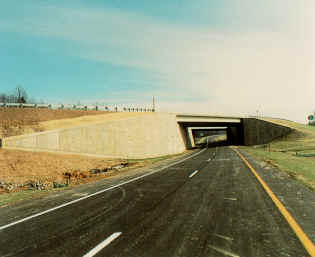Retaining Wall Design Program
Abstract
Analysis and design of cantilever retaining walls are performed. The program automatically considers active earth pressures and adjusts the coefficients for adjusted wall dimensions, checks stability of the wall with respect to sliding, soil pressure and overturning, and performs the section design of the stem and footing, including the reinforcement. Various options allow for the effects of point or infinite and finite uniform or line surcharge loadings. The effects of infinite or broken backfill cases can be considered and also automatically adjusted for varying wall dimensions. The foundation can consist of a spread footing with an option for a key or a pile group. The pile group analysis can consider the effects of the lateral stability afforded by the subgrade.
Program Scope
The general features and limitations of the program are:
- Various design specifications (AASHTO and ACI) are incorporated into the program;
- Moments, shears, and section designs are performed at a number of locations along the stem; default value can be specified, = 10;
- Subgrade for the pile foundation is idealized as being composed of uniform, elastic, isotropic material;
- All piles are considered to be prismatic; the maximum number of piles allowed = 20;
- Design can be performed on the pile group. The configuration is analyzed as given and row spacing, batter, and toe size are altered to give maximum representative wall length;
- The program will compute required steel areas for a given concrete section. In design mode, the batter of the stem will be increased, if necessary, and the footing thickness will be increased or decreased for an optimal design. The wall dimensions are checked for overturning, sliding, and soil pressure failure;
- The coefficients which define the active earth condition can be generated either automatically by the program or input directly. If generated automatically, the Rankine theory is assumed and the coefficients are adjusted automatically to account for varying heel lengths;
- In case of inadequate stability against sliding, a key may be considered for both the design and analysis options;
- Various surcharge cases can be considered, including the maximum number of surcharge cases = 9:
Point loads;
Line loads of a specified or infinite length parallel to stem;
Patch loads of a specified length and width;
Uniform loads of a specified width and a specified or infinite length. - The program may consider axial forces in the concrete design; it also may account for concentrated horizontal forces such as the impact of a truck striking a guard rail mounted on top of the wall;
- In determining the resistance of a retaining wall to sliding, the benefit of the passive soil pressure from the soil above the footing bottom is ignored. It is assumed that the soil below the footing bottom is undisturbed. The toe overburden is considered in computing vertical soil pressure. However, to be conservative in case the toe overburden is excavated, it is recommended that no toe overburden be input into the program.
- It is assumed that the backfill is a granular soil and well drained;
- RETWALL is a menu-driven program. The data input can be accessed through the preprocessor and the output through the print utility.
